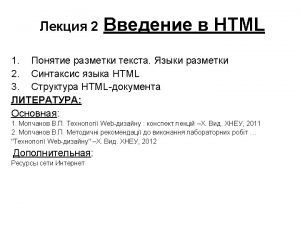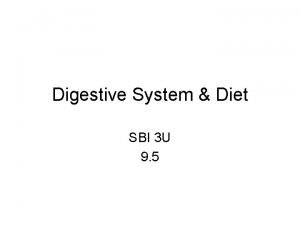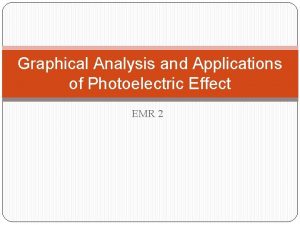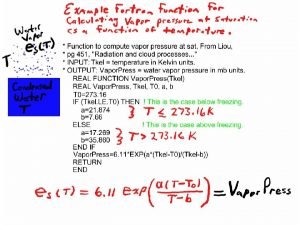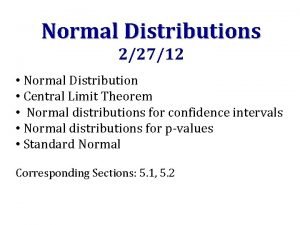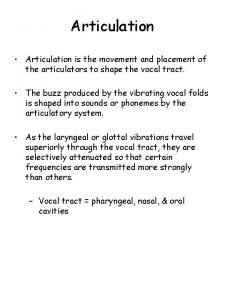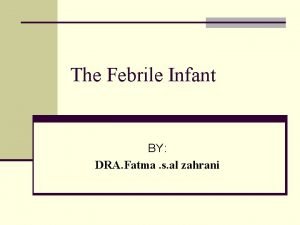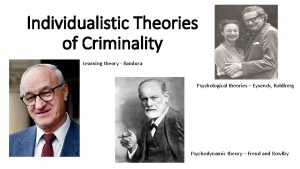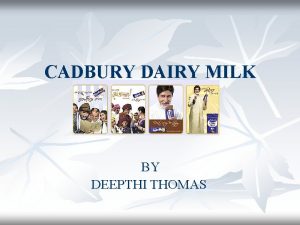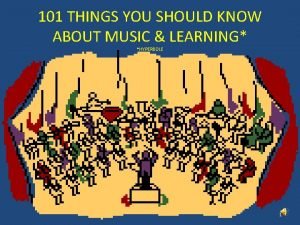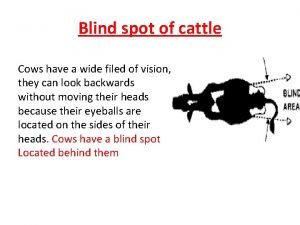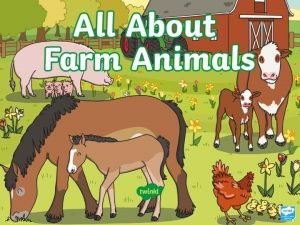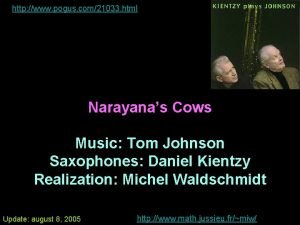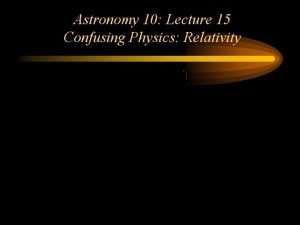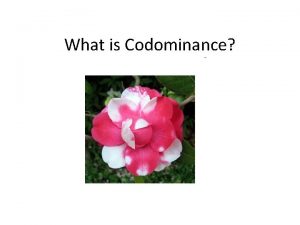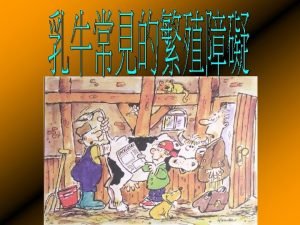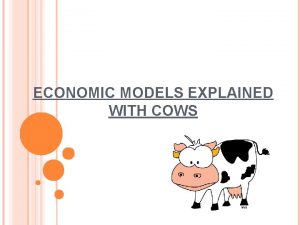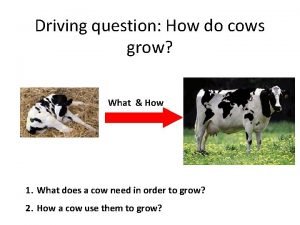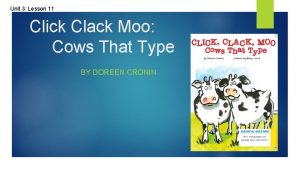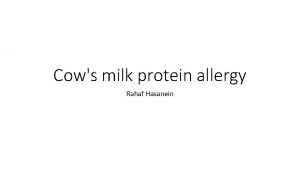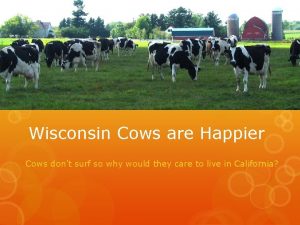http www pogus com21033 html Narayanas Cows Music

















































- Slides: 49

http: //www. pogus. com/21033. html Narayana’s Cows Music: Tom Johnson Saxophones: Daniel Kientzy Realization: Michel Waldschmidt Update: august 8, 2005 http: //www. math. jussieu. fr/~miw/

Narayana was an Indian mathematician in the 14 th. century, who proposed the following problem: A cow produces one calf every year. Begining in its fourth year, each calf produces one calf at the begining of each year. How many cows are there altogether after, for example, 17 years? While you are working on that, let us give you a musical demonstration.

The first year there is only the original cow and her first calf. Year 1 Original Cow 1 Second generation 1 Total 2 long-short

The second year there is the original cow and 2 calves. Year 1 2 Original Cow Second generation 1 1 1 2 Total 2 3 long -short

The third year there is the original cow and 3 calves. Year 1 2 3 Original Cow 1 1 1 Second generation 1 2 3 Total 2 3 4 long -short

The fourth year the oldest calf becomes a mother, and we begin a third generation of Naryana’s cows. Year 1 2 3 4 Original Cow 1 1 Second generation 1 2 3 4 Third generation 0 0 0 1 Total 2 3 4 6 long - short - long - short

The fifth year we have another mother cow and 3 new calves. Year 1 2 3 4 5 Original Cow 1 1 1 Second generation 1 2 3 4 5 +1 Third generation 0 0 0 1 3 +2 Total 2 3 4 6 9 +3

The sixth year we have 4 productive cows, 4 new calves, and a total herd of 13. Year 1 2 3 4 5 6 Original Cow 1 1 1 Second generation 1 2 3 4 5 6 Third generation 0 0 0 1 3 6 Total 2 3 4 6 9 13

The seventh year brings the birth of the first calf of Naryana’s original cow, and the fourth generation begins. Year Original Cow 1 2 3 4 5 6 7 1 1 1 1 Second generation 1 2 3 4 5 6 7 Third generation 0 0 0 1 3 6 10 Fourth generation 0 0 0 1 Total 2 3 4 6 9 13 19

In the eigth year the herd, which went from 1 to 2 to 3 to 4 to 6 to 9 to 13 to 19, now jumps to 28. Year 1 2 3 4 5 6 7 8 Original Cow 1 1 1 1 Second 1 generation 2 3 4 5 6 7 8 Third 0 generation 0 0 1 3 6 10 15 Fourth 0 generation 0 0 0 1 4 Total 3 4 6 9 13 19 28 2

In the ninth year, 13 new calves are born. 1 is the daughter of the original cow, 6 are granddaughters and 6 are greatgranddaughters. Year 1 2 3 4 5 6 7 8 9 Original Cow 1 1 1 1 1 Second generation 1 2 3 4 5 6 7 8 9 +1 Third generation 0 0 0 1 3 6 10 15 21 +6 Fourth generation 0 0 0 1 4 10 +6 Total 2 3 4 6 9 13 19 28 41 +13

In the tenth year, the herd of 41 grows to 60, and the fifth generation begins on a new note. Year Original Cow 1 2 3 4 5 6 7 8 9 10 1 1 1 1 1 Second generation 1 2 3 4 5 6 7 8 9 10 Third generation 0 0 0 1 3 6 10 15 21 28 0 0 0 1 4 10 20 0 0 0 0 1 2 3 4 6 9 13 19 28 41 60 Fourth generation Fifth generation Total

In the eleventh year an additional 28 calves are produced by 28 mothers, and 32 other calves are waiting to become mothers, making a total of 88.

Year Original Cow 1 2 3 4 5 6 7 8 9 10 11 1 1 Second generation 1 2 3 4 5 6 7 8 9 10 11 Third generation 0 0 0 1 3 6 10 15 21 28 36 Fourth generation 0 0 0 1 4 10 20 35 Fifth generation 0 0 0 0 0 Total 2 3 4 6 9 13 19 28 41 60 88 1 1 5

In the twelfth year, Narayana’s herd continues its population explosion, going from 88 to 129, and registrating an annual population growth of 46. 59 %

Year Original Cow 1 2 3 4 5 6 7 8 9 10 11 12 1 1 1 1 1 Second generation 1 2 3 4 5 6 7 8 9 10 11 12 Third generation 0 0 0 1 3 6 10 15 21 28 36 45 Fourth generation 0 0 0 1 4 10 20 35 56 Fifth generation 0 0 0 0 Total 2 3 4 6 9 13 19 28 41 60 88 129 0 1 1 1 5 1 15

Year 1 2 3 4 5 Original 1 1 1 Cow 6 7 8 9 10 11 12 1 1 1 1 Second 1 2 generation 3 4 5 6 7 8 9 10 11 12 Third 0 0 generation 0 1 3 6 10 15 21 28 36 45 Fourth 0 0 generation 0 0 1 4 10 20 35 56 Fifth 0 0 generation 0 0 0 0 1 5 15 2 3 4 6 9 13 19 28 41 60 88 129 Year Growth % 50 33 50 50 44. 4 46. 1 47. 3 46. 42 46. 34 46. 66 46. 59

In the thirteenth year, the rate drops very slightly to 46. 51 % as the sixth generation begins.

Year 1 2 3 Original 1 1 1 Cow 4 5 6 7 8 9 10 11 12 13 1 1 1 1 Second 1 2 3 generation 4 5 6 7 8 9 10 11 12 13 Third 0 0 0 generation 1 3 6 10 15 21 28 36 45 55 Fourth 0 0 0 generation 0 0 0 1 4 10 20 35 56 84 Fifth 0 0 0 generation 0 0 0 1 5 15 35 Sixth 0 0 0 generation 0 0 0 0 0 1 Total 6 9 13 19 28 41 60 88 129 189 2 3 4 1 1

Year 4 5 6 7 8 9 10 11 12 13 Original Cow 1 1 1 1 1 Second generation 4 5 6 7 8 9 10 11 12 13 Third generation 1 3 6 10 15 21 28 36 45 55 Fourth generation 0 0 0 1 4 10 20 35 56 84 Fifth generation 0 0 0 1 5 15 35 Sixth generation 0 0 0 0 0 1 Total 6 9 13 19 28 41 60 88 Growth % 50 50 44. 4 46. 1 47. 3 46. 42 46. 34 46. 66 129 189 46. 51

The fourteenth year brings 88 new calves, advancing the herd from 189 to 277.

Year 1 2 3 4 5 6 7 8 9 10 11 12 13 14 Original Cow 1 1 1 1 Second 1 2 3 generation 4 5 6 7 8 9 10 11 12 13 14 Third 0 0 0 generation 1 3 6 10 15 21 28 36 45 55 66 Fourth 0 0 0 generation 0 0 0 1 4 10 20 35 56 84 120 Fifth 0 0 0 generation 0 0 0 1 5 15 35 70 Sixth 0 0 0 generation 0 0 0 0 0 1 6 Total 6 9 13 19 28 41 60 88 129 189 277 2 3 4

Narayana's Cows, inspired by an Indian mathematician of the 14 th century, and playable on any combination of instruments, is written on three staves: the complete melody, the reduced bass melody, and the drone. The present multi-track saxophone version is probably as rich and energetic as any of the large ensemble versions. The melody is played by three overdubbed sopranino saxophones in unison, the bass line is played by three baritones, and the drone is played by three altos. http: //www. pogus. com/21033. html

Tom Johnson, born in Colorado in 1939, received degrees from Yale University, and studied composition privately with Morton Feldman. After 15 years in New York, he moved to Paris, where he has lived since 1983. He works with simple forms, limited scales, and generally reduced materials, but proceeds more logically than most minimalists, often using formulas, permutations, and predictable sequences. http: //www. tom. johnson. org

Daniel Kientzy is an international avant-garde artist, dedicated to contemporary music, exploiting the potential of all seven saxophones and the musical power of the electronic as well. Prior to his 25 years dedicated to this work, he participated professionally in almost all genres of western music, playing instruments as diverse as bass guitar, double bass, viola da gamba, recorder, bagpipes, and crumhorn. novamusica@infonie. fr

By the fifteenth year, the herd numbers 406. This includes the original cow, 15 daughters, 78 granddaughters, 165 great-granddaughters, 126 great-granddaughters, and 21 great-great-granddaughters.

Year 1 2 3 4 5 6 7 8 9 10 11 12 13 14 15 Original Cow 1 1 1 1 Second generation 1 2 3 4 5 6 7 8 9 10 11 12 13 14 15 Third generation 0 0 0 1 3 6 10 15 21 28 36 45 55 66 78 Fourth generation 0 0 0 1 4 10 20 35 56 84 120 165 Fifth generation 0 0 0 0 0 1 5 15 35 70 126 Sixth generation 0 0 0 1 6 21 Total 2 3 4 6 9 13 19 28 41 60 88 129 189 277 406

Narayana's Cows and Delayed Morphisms by Jean-Paul Allouche and Tom Johnson http: //kalvos. org/johness 1. html Six or eight years ago one of us (T. J. ) found a German edition of a little book on the history of mathematics by a Ukranian scholar named Andrej Grigorewitsch Konforowitsch. The book was full of curious information, but I was particularly struck by the following, which Konforowitsch attributed to Narayana, an Indian mathematician in the 14 th century:

A cow produces one calf every year. Beginning in its fourth year, each calf produces one calf at the beginning of each year. How many cows and calves are there altogether after 20 years? In working this out, T. J. came to know a unique numerical sequence, and a year or so later I found a way to translate this into a composition called Narayana's Cows. It begins with the original cow and her first calf: long-short. The second year she has another calf: long-short. http: //kalvos. org/johness 1. html

The third year: long-short-short. Then in the fourth year, the first calf also becomes a mother and the herd grows from four to six: long-short-short-long-short. The music continues like this, though it doesn't go all the way to the 20 th year, because by the 17 th year there already more than 800 cows and calves and 15 minutes of music. http: //kalvos. org/johness 1. html

Many things can be said about the mathematics of Narayana's cows, about different ways to translate them into music, about the point at which the calves begin to outnumber the cows, about the rate of population increase, the limit which this rate approaches, and so on. The essence of the problem, however, is simply the sequence resulting as the years go by: 1, 2, 3, 4, 6, 9, 13. . . http: //kalvos. org/johness 1. html

1, 2, 3, 4, 6, 9, 13. . . Like the Fibonacci sequence, each number is calculated by adding earlier numbers, but instead of adding the two previous numbers, as one does for the Fibonacci series, one adds the previous number in the sequence plus the number two places before that: Sn = Sn-1 + Sn-3. The last number above is 13 (=9 + 4) and the next must be 19 (=13 + 6). http: //kalvos. org/johness 1. html

In the sixteenth year, we have 1 new daughter, 13 new granddaughters, 55 new great-granddaughters, 84 new great-granddaughters, 35 new great-great-granddaughters and the very first great-great-greatgranddaughter.

Year 1 2 3 4 5 6 7 8 9 10 11 12 13 14 15 16 Original 1 1 1 Cow 1 1 1 1 Second generation 1 2 3 4 5 6 7 8 9 10 11 12 13 14 15 16 Third generation 0 0 0 1 3 6 10 15 21 28 36 45 55 66 78 91 Fourth generation 0 0 0 1 4 10 20 35 56 84 120 165 220 Fifth generation 0 0 0 0 0 1 5 15 35 70 126 210 Sixth generation 0 0 0 1 6 21 56 Seventh generation 0 0 0 0 1 Total 2 3 4 6 9 13 19 28 41 60 88 129 189 277 406 595

Quiz: What is the ultimate annual population growth of this herd? The first correct answer wins a CD of Narayana’s cow

Let Sn be the total number of cows at the end of the year n S 0 =1, S 1 = 2 , Sn = Sn-1+ Sn-3. S 2 = 3 , S 3 = 4 , S 4 = 6 , S 5 = 9 , S 6 = 13, S 7 = 19, … 1, 2, 3, 4, 6, 9, 13, 19, 28, 41, 60, 88, 129, 189, 277, 406, 595, …

Let Un satisfy Un = Un-1+ Un-3 and let a=U 0 , b=U 1 , Then U 3 = a+c, U 4 = a+b+c, U 5 = a+b+2 c, U 6 = 2 a+b+3 c, U 7 = 3 a+2 b+4 c, U 8 = 4 a+3 b+6 c, … c=U 2. Recall Sn : S 0 =1, S 1 = 2, S 2 = 3, S 3 = 4, S 4 = 6, … Hence Un = Sn-5 a + Sn-6 b+ Sn-4 c.

Let x be such that Un = xn satisfies Un = Un-1+ Un-3. Then x 3 = x 2 + 1. Positive solution: Narayana’s constant = 1. 465571231876…

Now we arrive at the seventeenth and final year of the problem. Most of you have probably already calculated what the population has to be now, but if you haven’t, or if you want to check your work, you can always just count the notes as we play.

PV Numbers A PV number is a positive algebraic integer greater than 1, all of whose conjugate elements have absolute value less than 1: is a root of an equation n + an-1 +…+ a 1 + a 0 =0 with integers ai and all other roots of that equation are complex numbers in the disc |z|<1. 0 1

Pisot (1938) and Vijayaraghavan (1941) independently studied these numbers, and Salem (1943) proposed calling such values Pisot-Vijayaraghavan numbers. PV numbers

The smallest PV number is given by the positive root 1. 324717957. . . of x 3 -x-1=0. This number was identified as the smallest known by Salem (1944), and proved to be the smallest possible by Siegel (1944).

Formula for Sn : n n n Sn = a + b +b where x 3 - x 2 - 1 = (x- )(x- ). =1. 46557…, | | = 0. 8260…<1. Sn+1/ Sn . The ultimate annual population growth of this herd is 46. 55%

Numerical values: n n n Sn = a + b , a=1. 3134…, =1. 46557… n For n ≥ 4, Sn is the nearest integer to a n. = 4, 5, 6, 7, 8, a n = 6. 05, 8. 88, 13. 01, 19. 07, 27. 94, Sn = 6, 9, 13, 19, 28, 9, … 40, 96, … 41, …

Further examples: Fix k ≥ 1, let un =un-1+un-k. For k = 1 geometric sequence: un =2 un-1 1, 2, 4, 8, 16, 32, 64, 128, … un = 2 n A mouse produces one new mouse every year. Begining in its second year each mouse produces one mouse at the begining of each year. Annual rate of growth: 100%.

Further examples: Fix k ≥ 1, let un =un-1+un-k. For k = 2, un =un-1+un-2, Fibonacci rabbits: A rabbit produces one new rabbit every year. Begining in its third year each rabbit produces one rabbit at the begining of each year: 1, 2, 3, 5, 8, 13, 21, 34, 55, 89, 144, … Annual rate of growth: 61. 80% 1+ 5 The Golden Number: =1. 6180339… 2

Further examples: Fix k ≥ 1, let un =un-1+un-k. For k = 3, un =un-1+un-3 , Narayana’s cows 1, 2, 3, 4, 6, 9, 13, 19, 28, 41, 60, … Annual rate of growth: 46, 55% k sequence 1 Exponential 1, 2, 4, 8, 16, 32, … 2 Fibonacci 1, 2, 3, 5, 8, 13, 21, … 3 Narayana 1, 2, 3, 4, 6, 9, 13, 19, … 4 un =un-1+un-4 1, 2, 3, 4, 5, 7, 10, 14, … rate growth 100% 61, 80% 46, 55% 38, 02%

Year 1 2 3 4 5 6 7 8 9 10 11 12 13 14 15 16 17 1 1 1 1 Second generation 1 2 3 4 5 6 7 8 9 10 11 12 13 14 15 16 17 Third generation 0 0 0 1 3 6 10 15 21 28 36 45 55 66 78 91 105 Fourth generation 0 0 0 1 4 10 20 35 56 84 120 165 220 286 Fifth generation 0 0 0 0 0 1 5 15 35 70 126 210 330 Sixth generation 0 0 0 1 6 21 56 126 Seventh generation 0 0 0 0 1 7 Total 2 3 4 6 9 13 19 28 41 60 88 129 Original 1 1 1 Cow 189 277 406 595 872

http: //www. pogus. com/21033. html Narayana’s Cows Music: Tom Johnson Saxophones: Daniel Kientzy Realization: Michel Waldschmidt http: //www. math. jussieu. fr/~miw/
 Music music music
Music music music Head body html
Head body html Bhtml?title=
Bhtml?title= Doctype html html head
Doctype html html head 1
1 Html
Html @arya ia:http://work4unity.in/haicantik.html noh salin aj
@arya ia:http://work4unity.in/haicantik.html noh salin aj Http://geosevillano.blogspot.com/p/blog-page_6.html
Http://geosevillano.blogspot.com/p/blog-page_6.html Http://www.innerbody.com/htm/body.html
Http://www.innerbody.com/htm/body.html Kcvs.ca
Kcvs.ca Http //early humans.mrdonn.org/tools.html
Http //early humans.mrdonn.org/tools.html Http //kidshealth.org/kid/htbw/digestive system.html
Http //kidshealth.org/kid/htbw/digestive system.html Http://weather.uwyo.edu/upperair/sounding.html
Http://weather.uwyo.edu/upperair/sounding.html @arya ia:http://work4unity.in/haicantik.html
@arya ia:http://work4unity.in/haicantik.html Davidmlane com hyperstat index html
Davidmlane com hyperstat index html Uvular
Uvular Harcourtschool.com/activity/food/food menu.html
Harcourtschool.com/activity/food/food menu.html @katochimotokidoari:http://work4unity.in/haicantik.html
@katochimotokidoari:http://work4unity.in/haicantik.html Http ://stsp.creteil.iufm.fr/article89.html
Http ://stsp.creteil.iufm.fr/article89.html Http://metrocosm.com/global-migration-map.html
Http://metrocosm.com/global-migration-map.html @kuanlyna fatma:http://m.2265.com/down/132284.html
@kuanlyna fatma:http://m.2265.com/down/132284.html Index of http
Index of http Membuat garis html
Membuat garis html James bulger case social learning theory
James bulger case social learning theory Number of neutrons xenon
Number of neutrons xenon B) http://www.schoolguides.com/types_of_scholarships.html
B) http://www.schoolguides.com/types_of_scholarships.html Http://weather.uwyo.edu/upperair/sounding.html
Http://weather.uwyo.edu/upperair/sounding.html Music that employs electronic music
Music that employs electronic music Ilocano name for the wind instrument
Ilocano name for the wind instrument Classical vs romantic art
Classical vs romantic art Is organized into recognizable/recurring accent patterns
Is organized into recognizable/recurring accent patterns Cows are omnivores
Cows are omnivores Cadbury silk
Cadbury silk Alexander luria
Alexander luria Rombergs test
Rombergs test You have two cows
You have two cows Cow kicker rope
Cow kicker rope Drsabcd definition
Drsabcd definition Cows give us
Cows give us Narayana's cows sequence
Narayana's cows sequence What time is it
What time is it What is codominance? *
What is codominance? * Cows flowsheet
Cows flowsheet Mild hydrometra
Mild hydrometra Socialism explained with cows
Socialism explained with cows How do cows grow
How do cows grow Male reproductive system of cattle
Male reproductive system of cattle Political ideologies cows
Political ideologies cows Click, clack, moo cows that type comprehension questions
Click, clack, moo cows that type comprehension questions Cows test nystagmus
Cows test nystagmus





